- 1Department of Pedagogy and Medical Psychology, I.M. Sechenov First Moscow State Medical University (Sechenov University), Moscow, Russia
- 2Faculty of Psychology, Russian State Social University, Moscow, Russia
- 3Department of Information Security, Financial University Under the Government of the Russian Federation, Moscow, Russia
- 4Department of Information Security, Russian State University for the Humanities, Moscow, Russia
- 5Department of Strategic Information Studies, National Research Nuclear University “MEPhI”, Moscow, Russia
- 6Department of History, Moscow Aviation Institute (National Research University) (MAI), Moscow, Russia
- 7Department of State-Legal and Criminal Law Disciplines, Plekhanov Russian University of Economics, Moscow, Russia
- 8Department of Social, Psychological and Legal Communications, Moscow State University of Civil Engineering (MGSU), Moscow, Russia
- 9Department of the English Language for Professional Activities, Ulyanovsk State University, Ulyanovsk, Russia
The pandemic has created a push for changes in education and technology that are driving progress in all areas of instruction. This impetus is forcing all stakeholders to address the transformation of traditional education into online education. This change in the education system requires students and teachers to train new competencies, knowledge, skills, and abilities. In this context, this paper aimed to determine the psychophysiological strain of university students in relation to distance learning during the pandemic COVID-19. For this aim, quantitative data collection was conducted in this research. The results indicated that the distance learning format increased neuropsychic strain, decreased mood, activity, and wellbeing, and increased situational anxiety in college students. Based on the obtained results, social pedagogical educational technologies were developed, and hybridity, interactivity, multiformat, and feedback were identified as the main factors for their success. Pedagogical implications for teaching in higher education are presented.
Introduction
The current status of social and personal space caused by the pandemic COVID-19 requires a change in established patterns of life perspectives and landmarks, as well as in responding to new challenges. As humanity moves into the era of global informatization and digitalization, education becomes a continuous process, an important part of everyone’s life, ensuring their full, comprehensive development and self-realization (Dryhurst et al., 2020; Kugurakova et al., 2021).
The new reality under changing conditions requires adaptation to unique needs and solving new complex problems. In this context, determining the internal characteristics of students’ transition to new internet spaces and acquiring digital competencies in learning becomes important (Salakhova et al., 2021a). The experience of transitioning to a different space of developing important skills and abilities leads to the formation of frustrating agents involved in the development of an individual and the construction of knowledge (Kayumova et al., 2021). The acquisition of knowledge at the level of different realities of traditional and digital learning technologies requires the search for optimal forms of application of combined technologies, which can lead to the adaptation of students’ perception of educational materials and, as a result, to the inclusion of new resources and activation of cognitive activity (Ammerman et al., 2020; Bringle and Clayton, 2020; Culcasi, 2020; Dhahri et al., 2020; Garcia-Gutiérrez et al., 2020; Gerhold, 2020; Meija, 2020; Zhang et al., 2020; Villegas et al., 2021). Currently, there is an active discussion about the nature and content of the educational process in a distance format, about the conditions and the environment in which the learning and development process takes place in the educational setting in the context of the pandemic COVID-19. This context requires a revision of the new education’s foundations and considering a new paradigm in the educational system (Petrakova et al., 2021; Varlamova and Manvelova, 2021).
The XXI century is the age of compromise between two extremes: conservative, traditional education, and pragmatic digital education, which categorically asserted its rights during the pandemic. The pandemic has provided the impetus for changes in technology, methods, and business models that could lead to progress that benefits a broad spectrum of learners. This progress will be in bridging the boundaries between online and offline education, theory, and practice becoming more accessible to extended reality (XR) technologies. All these development lays a new education that will determine the development of all humanity (Bayanova et al., 2019; Masalimova et al., 2019; Fiorillo and Gorwood, 2020; Ho et al., 2020; Holmes et al., 2020; Sood, 2020; Garciìa-Gutieìrrez et al., 2021; Qarkaxhja et al., 2021; Salakhova et al., 2021b; Montiel and Georgina, 2022).
Scholars have conducted a large number of studies about higher education students during the period of COVID-19. However, few studies have looked at the psychophysiological strain of higher education students regarding distance learning during the COVID-19 pandemic. For example, Beltrán-Velasco et al. (2020) investigated the psychophysiological stress response of psychology students and analyzed the impact of cultural differences between Colombia and Spain. Results showed that students’ psychophysiological stress was influenced by factors such as culture, stressful environment, and psychological factors. They also found that Colombian students had higher sympathetic activation than Spanish students. Rodriguez-Besteiro et al. (2021) examined risk perception and gender differences among university students in Spain. They also examined the psychophysiological stress response of the students. Their results showed that women perceived the risk of the COVID-19 virus more than men. They also found that women had higher scores on anxiety, conscientiousness, neuroticism, and openness to experience, while men had higher scores on extraversion. The results of these studies revealed some information about the psychophysiological strain of higher education students during the pandemic.
On the other hand, some studies, such as Clemente-Suárez et al. (2020) and Soylu (2021), have examined the psychophysiological consequences of the pandemic COVID-19. For example, Clemente-Suárez et al. (2020) reviewed the literature on the psychophysiological consequences of the pandemic COVID-19. However, while Clemente-Suárez et al. (2020) and Soylu (2021) examined the psychophysiological consequences of COVID-19, they did not examine the effects of distance learning on the psychophysiological strain. For this reason, there is a need to investigate the psychophysiological strain of higher education students concerning distance learning during the pandemic. Therefore, this paper aims to examine the psychophysiological strain of higher education students in relation to distance education during the pandemic.
Materials and methods
The analysis of the current system of higher professional education during the COVID-19 pandemic and, as a result, the active introduction of digital technologies into the learning process led to the conclusion that the changing paradigm of the educational system requires that all subjects of educational relations should form new competencies and skills, a new format of a “digital personality.” The processes of adaptation to stressful situations and the ability of a person to develop coping behaviors come to the fore. In this regard, there is a need to provide students and college teachers with the necessary resources for an effective transition to a digital learning format. The psychophysiological condition of students and college teachers during restructuring the entire educational system requires special attention. In light of the above, we conducted an empirical study to examine the psychophysiological strain of college students during the period of distance learning during the pandemic COVID-19. The psychophysiological strain is conceptualized “as an intervening variable between recent life change and negative change in health” by Garrity et al. (1977). According to this definition, the psychophysiological strain may be considered the reason that causes the negative change in a person’s mind.
The empirical study included 184 full-time and part-time psychology students (weekend groups) studying in the psychology program at the First Sechenov Medical College, the Russian State Social College, the Financial College of the Government of the Russian Federation, and the Moscow Aviation Institute, and the Plekhanov College of Economics. The participants included first-year students (n = 50), second-year students (n = 37), third-year students (n = 43), fourth-year students (n = 34), and fifth-year students (n = 20). The average age of the participants was 31.5 ± 6.3 years. The youngest participants were 19 years old, and the oldest was 56. All students were divided into two subgroups. The first subgroup included participants aged 19–28 years. The second group included participants aged 29–56 years. The number of subjects for each year concerning their classification into age subgroups is shown in Table 1. The inclusion criteria for participants were (i) enrollment in an undergraduate psychology program at a university and participation in distance learning during COVID-19. One of the researchers informed all participants of the purpose of this study. The participants volunteered to participate in the study. After ethical review and approval from the university, where the questionnaires were given to the participants, data collection was conducted by the researchers.
To explore the psychophysiological level of psychology students, we used the neuropsychological stress questionnaire developed by Nemchin (1983) and the physical state-activity-mood questionnaire (PSAM), the situational anxiety inventory used by Spielberger et al. (1970) (Spielberger et al., 1980; Spielberger, 1985; Bonke et al., 1987; Greben, 2007; Spielberger and Reheiser, 2009). The Situational Anxiety Inventory consisted of 20 items and is scored on a 4-point Likert scale. In answering the questions of this situational anxiety questionnaire, participants express their current feelings. Each of the test questions has scores from 1 to 4. Spielberger’s Anxiety Inventory is among the most commonly used by researchers to determines the anxiety levels of individuals (Mohammadi et al., 2019).
To determine the school environment’s influence on higher education students’ psychophysiological levels, the survey was administered twice before classes began (9:00 a.m.) and after classes ended (6:00 p.m.). Statistical data processing was performed using the computer program Statistica-19. Descriptive statistics, chi-square test, Fisher test, and Spearman correlation analysis were used to answer the research question during the analyses. To test the reliability of the inventory, we performed the Cronbach’s alpha test using the data from this study. The researchers determined a reliability of 0.83 as a Cronbach’s α value for the neuropsychological stress questionnaire. Reliability for the PSAM was found to be 0.85. Another reliability value for the situational anxiety test was found to be 0.80. All questionnaires used in this study have been used by previous researchers to study psychophysiological strain of students. The validity studies of the Russian versions of the questionnaires were conducted by these researchers.
Results
The results of the frequency of occurrence of different levels of intensity of neuropsychological stress in psychology students (hereafter referred to as NPS) before and after classes are presented in Tables 2, 3. The study results show that at the beginning of the lectures, only a small number of full-time and part-time psychology students (weekend groups) in both age groups from the first to the fourth year of study showed moderate neuropsychological stress. Thus, the range of moderate NPS among psychology students in the first age group was 5−16.7%, and in the second age group was 5.9−26.3%. The obtained results show that only a quarter of subjects before the beginning of classes showed mobilization of mental activity, increase in activity of somato-vegetative functions, increase in moral, psychological, and physical strength, a manifestation of motivation to achieve a goal, desire for energetic actions, prevalence of positive emotional background, good mood, activation of the desire to overcome difficulties and achieve good results, increase in the effectiveness of attention characteristics (increase in volume and concentration, decrease in distraction), changes in memory functions, increase in the productivity of logical thinking, increase in the accuracy of movements, drop in the number of errors.
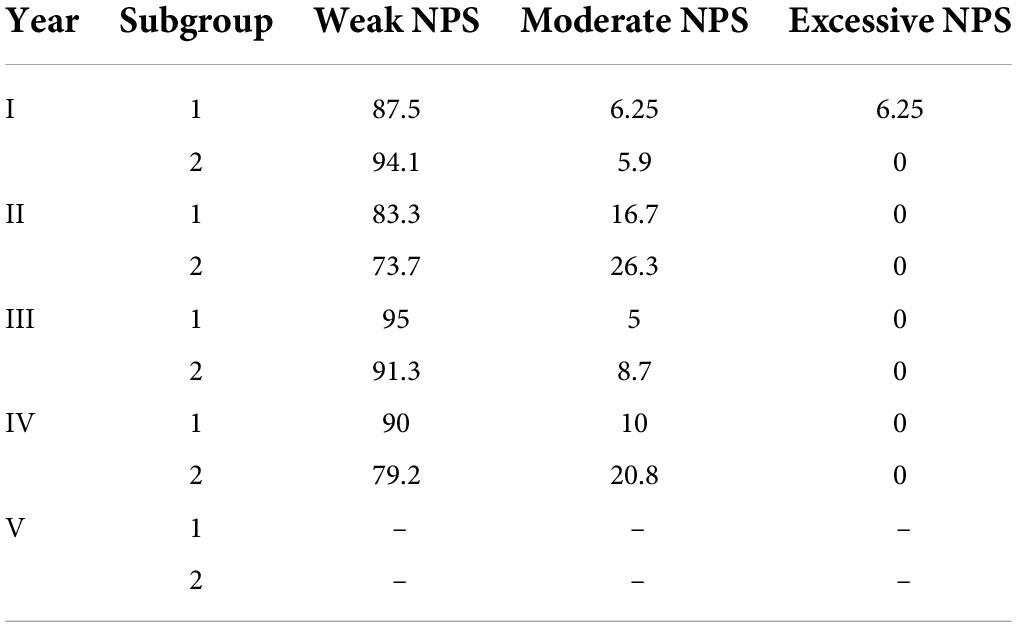
Table 2. Frequency of occurrence of different levels of neuropsychic strain in psychology students before classes (in %).
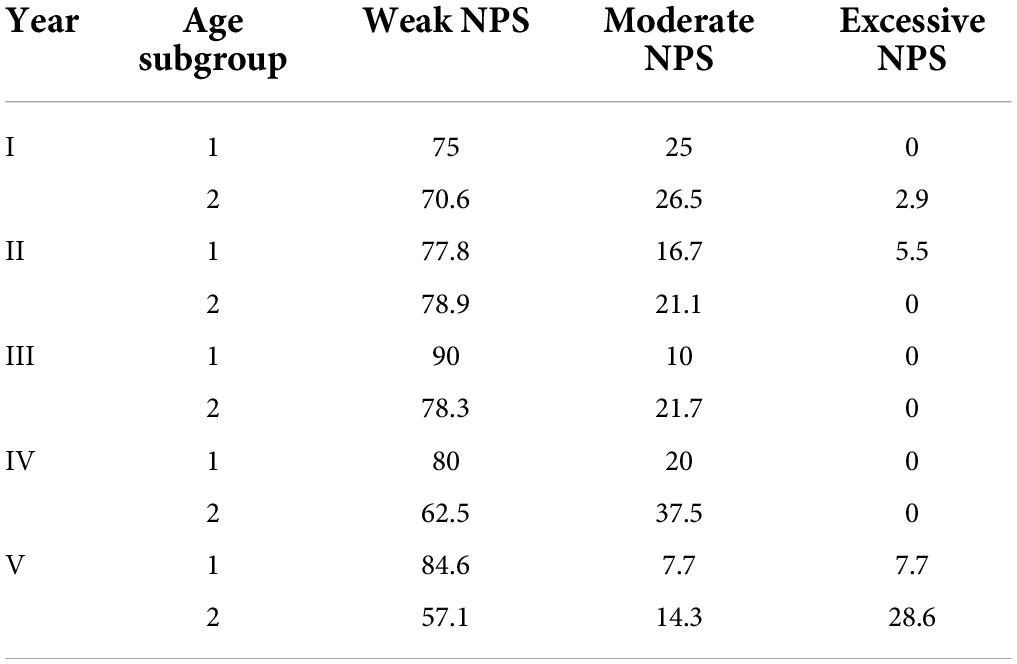
Table 3. Frequency of occurrence of different levels of the neuropsychic strain intensity in psychology students after classes (in %).
The results of the study of the NPS level before the start of lectures in full-time and part-time psychology students (weekend groups) from the first to the fourth year of study, aged between 19 and 28 and between 29 and 56 years, showed that regardless of age and year of study, moderate neuropsychic load, which is a prerequisite for the performance of cognitive activities, is found only in a quarter of the students. At the end of the lectures, more than half of the full-time and part-time psychology students (weekend groups) in all age groups from the first to the fourth year of study showed a weak level of NPS. For example, the range of weak NPS among psychology students in the first age group was 75−84.6%, and in the second age group was 62.5−78.3%. The survey results indicate that at the end of the learning activity, more than half of the respondents either showed no signs of stress or the manifestations were so insignificant that the subjects did not consider their condition as neuropsychological stress. In addition, at the end of the learning activity, the subjects did not feel they were “locked into” the learning situation. They did not perceive it as difficult and did not have to make an effort to overcome it. There were no motivations to achieve the goal and complete the activity. The students did not feel the need to overcome difficulties. They were not interested in the outcome of the activity. The subjects did not notice any phenomena of somatic or mental discomfort or, on the contrary, wellbeing; they did not show any significant changes suggesting their status as one of tension. Thus, the strain on the psychology students at the end of the educational activity did not differ from their normal status. The characteristics of the somato-vegetative systems and the mental sphere corresponded to those of everyday life.
The results of the survey of the NPS level in full-time and part-time psychology students (weekend group) from the first to the fourth year of study, aged between 19 and 28 and between 29 and 56 years, showed that regardless of age and year of study, at the end of the educational activity more than half of the subjects had no “involvement” in the learning situation, they did not consider it difficult, which required the mobilization of efforts to cope with it, there were no motives both for achieving the goal and for carrying out the activity, they were not interested in the outcome of the activity. The 12-h educational process for psychology full-time and part-time students requires a special pedagogical and methodological organization. The results of the change of neuropsychic load level during the educational activity in full-time and part-time school psychology (weekend groups) students of the first, second, third, and fourth years of study in the first and second age subgroups are presented in Figures 1, 2.
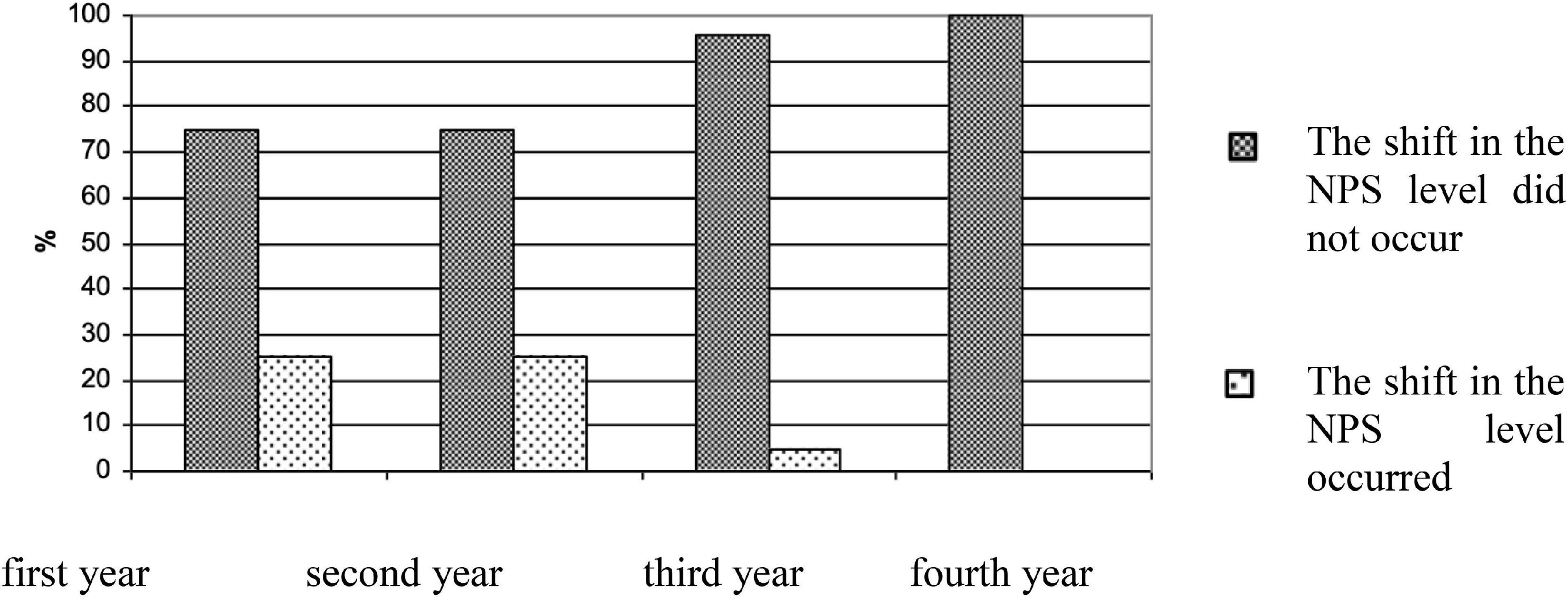
Figure 1. Frequency of occurrence of a changed and unchanged level of neuropsychic strain in psychology students of the first age subgroup during the academic day (in %).
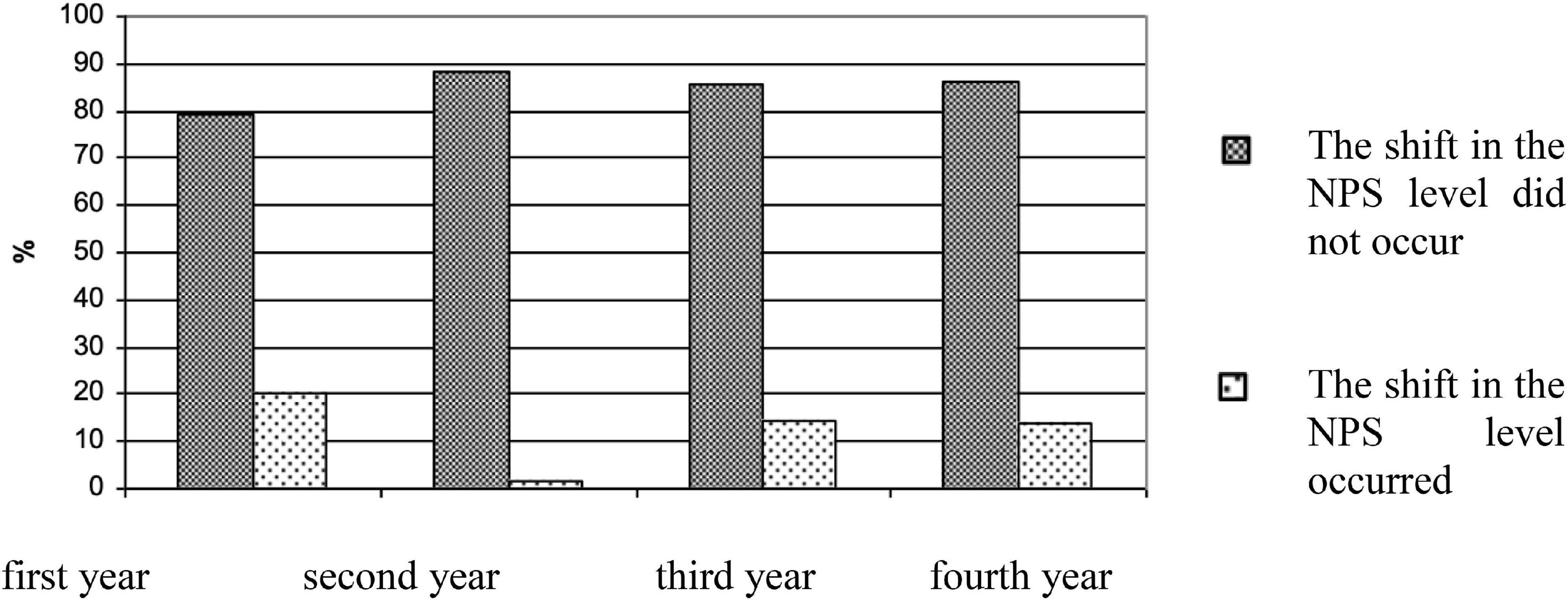
Figure 2. Frequency of occurrence of a changed and unchanged level of neuropsychic strain in psychology students of the second age subgroup during the academic day (in %).
As we can see in Figures 1, 2, more than half of the full-time and part-time psychology students (weekend groups) from the first to the fourth year of study in the first and second age subgroups showed no shift in NPS level. Thus, the range of occurrence of zero growth (no changes) of the NTP level during the educational activity was 75−100% in the first age subgroup of psychology students from the first to the fourth year of study, and −79.4−88.2% in the second age subgroup. The obtained data show that the 12-h learning activity neither improved nor worsened the level of neuropsychic load in more than half of the subjects. A more detailed examination of the variants of the zero shift manifestation in the NTP level at the beginning and the end of instruction yielded the results reproduced in Figures 3, 4.
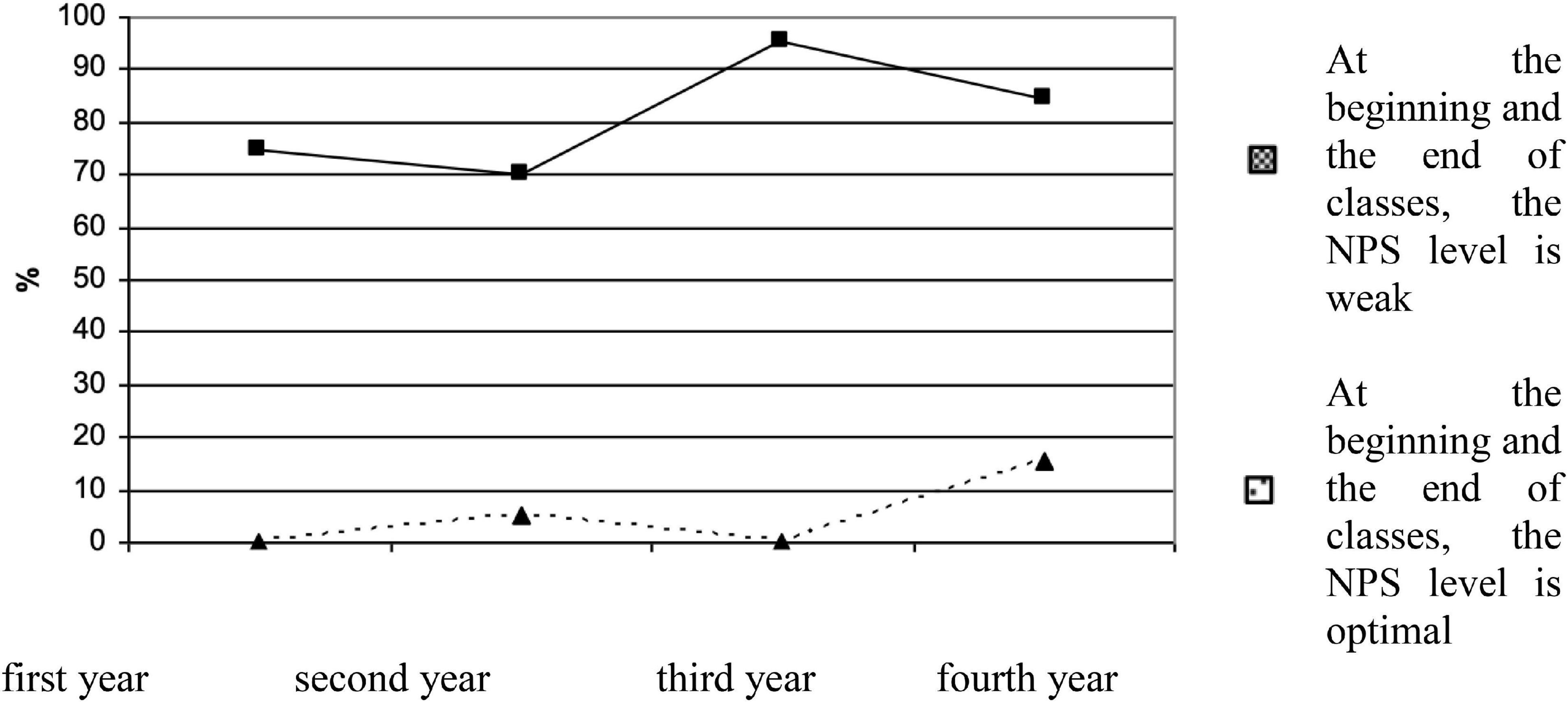
Figure 3. Frequency of occurrence of different variants of the zero shift in the level of neuropsychic strain in psychology students of the first age subgroup (in %).
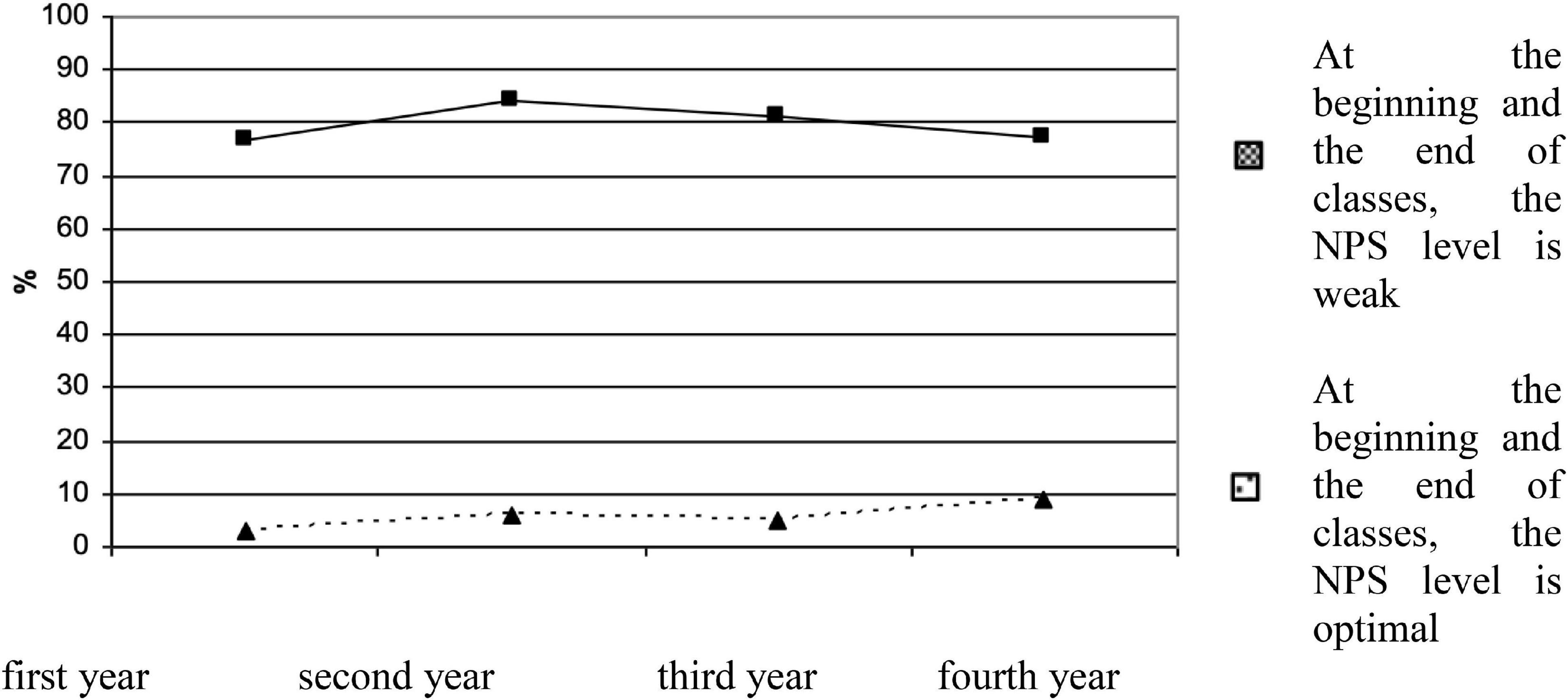
Figure 4. Frequency of occurrence of different dynamic patterns of the zero shift in the level of neuropsychic strain among psychology students of the second age subgroup (in %).
The survey results show that most full-time and part-time psychology students (weekend groups) from the first to the fourth year of study in the first and second age subgroups maintained a weak NPS level during the academic day. Thus, the frequency range of an inadequate NPS level at the beginning and end of class was 70−95.5%–for respondents in the first age subgroup and 76−84.2%–for respondents in the second age subgroup. The results show that regardless of age and year of study, the beginning and end of instruction for most psychology students occurred against a background of low NPS levels. The results of the survey address the dynamic patterns of neuropsychological stress levels from the beginning to the end of the 12-h educational activity for full-time and part-time psychology students (weekend groups) in the first, second, third, and fourth years of study of the first and second age subgroups, are presented in Figures 5, 6.
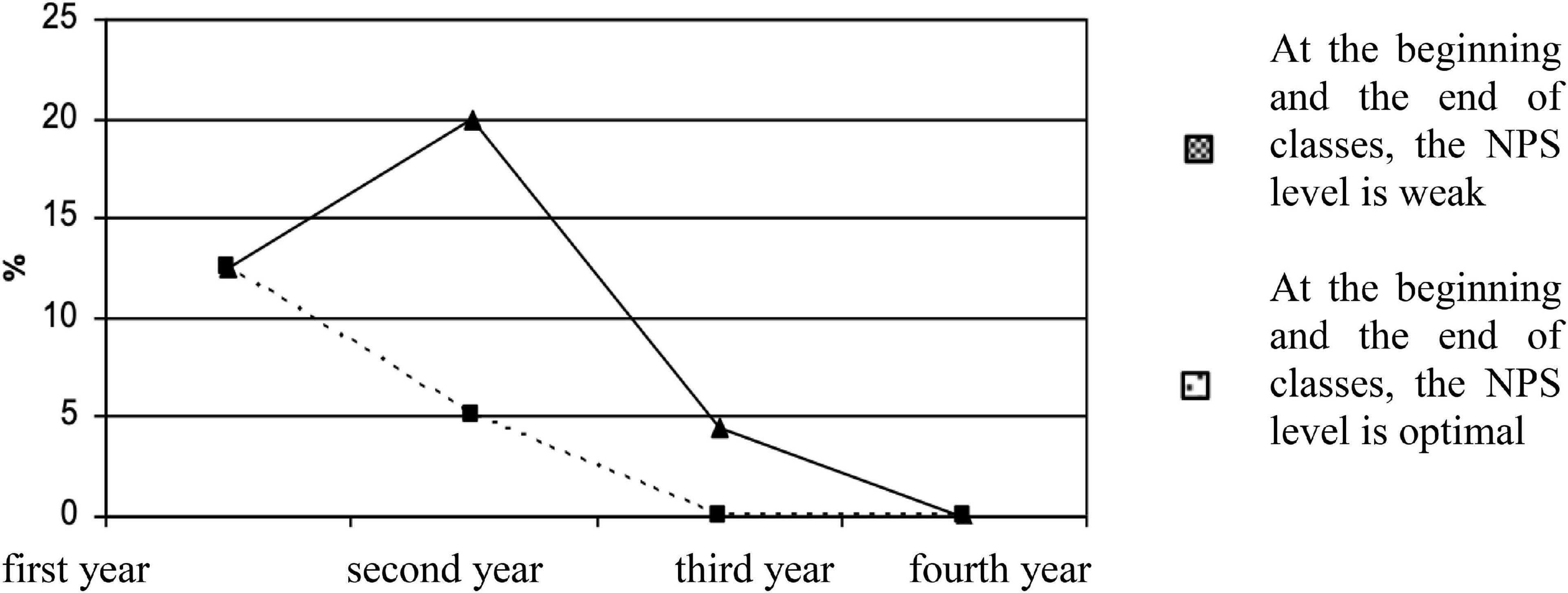
Figure 5. Frequency of occurrence of different dynamics patterns in the level of a neuropsychic strain of psychology students in the first age subgroup from the beginning to the end of classes (in %).
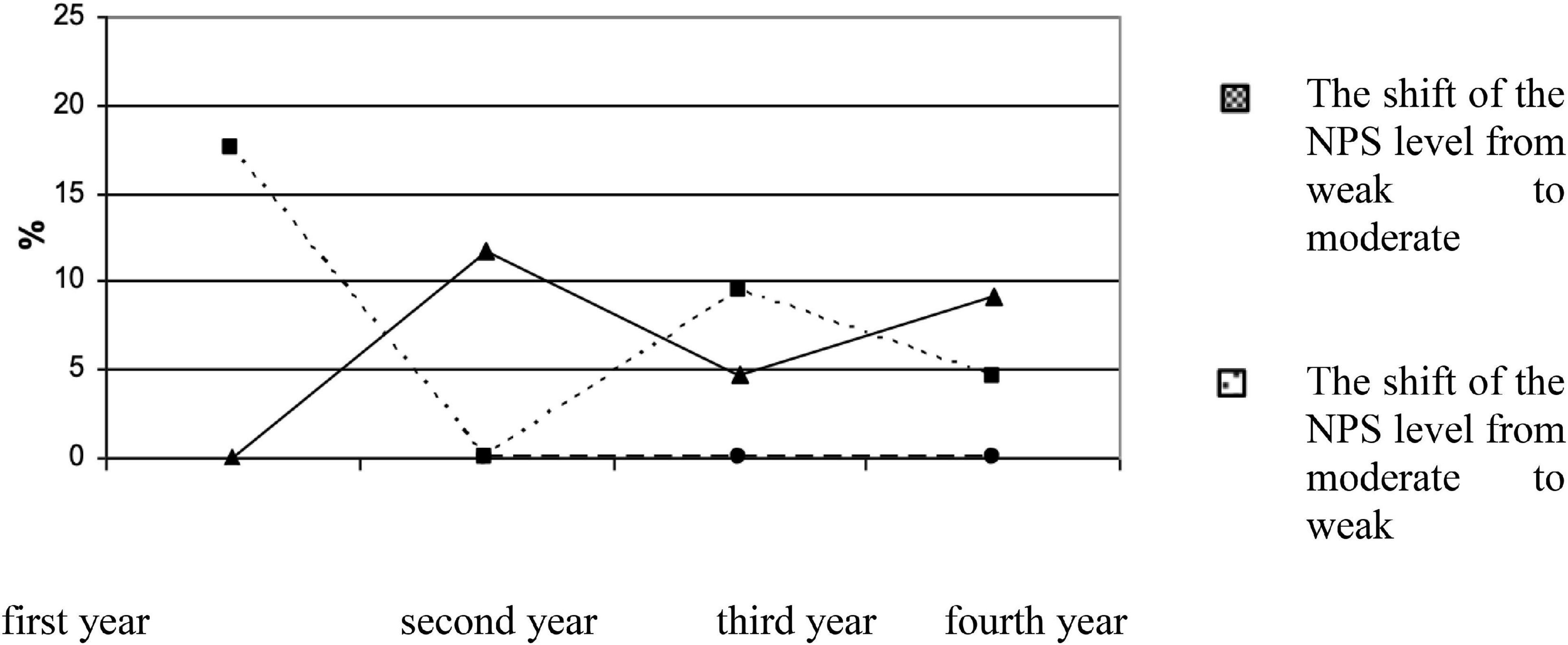
Figure 6. Frequency of occurrence of different dynamics patterns in the level of neuropsychic strain in psychology students of the second age subgroup from the beginning to the end of classes (in %).
For psychology students from the first to the fourth year of study, aged between 19 and 56 years, two patterns of a shift in NPS level were found, from moderate level (at the beginning of the study) to weak level (at the end of study) and from inadequate level (at the beginning of the study) to moderate level (at the end of study) (Figure 5). Thus, the frequency of a positive shift (from a low to an intermediate level) and a negative shift (from a moderate to a low level) was the same for first-year students in the first age subgroup and was 12.5%. In the second-and third-year students, cases of a negative shift in neuropsychic load (from a moderate–at the beginning–to a low level–at the end of the class) were found more frequently, at 20 and 4.5%, respectively. No changes in neuropsychic load were found in the fourth-year psychology students of the first age group. Moreover, the frequency of positive and negative changes in NPS levels tended to decrease from the first to the fourth year of study among the full-time and part-time psychology students of the first age subgroup. For example, the frequency of a positive shift in NPS level [from a weak NPS level (at the beginning of instruction) to a moderate NPS level (at the end of instruction)] among first age subgroup psychology students in the first, second, third, and fourth years of study was 12.5, 5, and 0% of the cases, respectively. The frequency of a negative shift in NPS level [from a moderate NPS level (at the beginning of instruction) to a weak NPS level (toward the end of instruction)] among first age subgroup psychology students in the first, second, third, and fourth years of study was 12.5, 20, 4.5, and 0% of cases, respectively.
The frequency of shifting the level of neuropsychic stress from the beginning to the end of classes in psychology students of the second age subgroup in the first, second, third, and fourth years of full-time training (weekend groups) was low. It was 17.6, 6, 0, 9.5, and 4.5% of cases for the degree of change of NPS from weak to a moderate level, and 0, 11.8, 4.8, and 9.1% for the degree of change from average to inadequate level, respectively (Figure 6). As in the first age group, a tendency to decrease the positive difference in the level of NPS from the first to the fourth year was observed. Thus, the frequency of occurrence of a positive shift [from a weak level of NPS (at the beginning of instruction) to a moderate level of NPS (at the end of instruction)] in the first, second, third, and fourth years of study was 17.6, 0, 9.5, and 4.5%, respectively.
The study results showed that there were significant differences between study years in the first age group in such parameters of NPS as temperature sensation (p = 0.034), sleep (p = 0.04), emotional strain in general (p = 0.011), memory (p = 0.029), mental performance (p = 0.023). Significant differences were also shown between the study years in the second age group in relation to such parameters of neuropsychic stress as susceptibility, sensitivity to external stimuli (p = 0.049), feelings of confidence in one’s own strength, abilities (p = 0.038), speech (p = 0.03), the degree of stress intensity (p = 0.026). The results of the frequency of occurrence of different levels of agility, speed, and rate of psychophysical functions (activity) in full-time and part-time psychology students (weekend groups) before and after classes are given in Tables 4, 5.
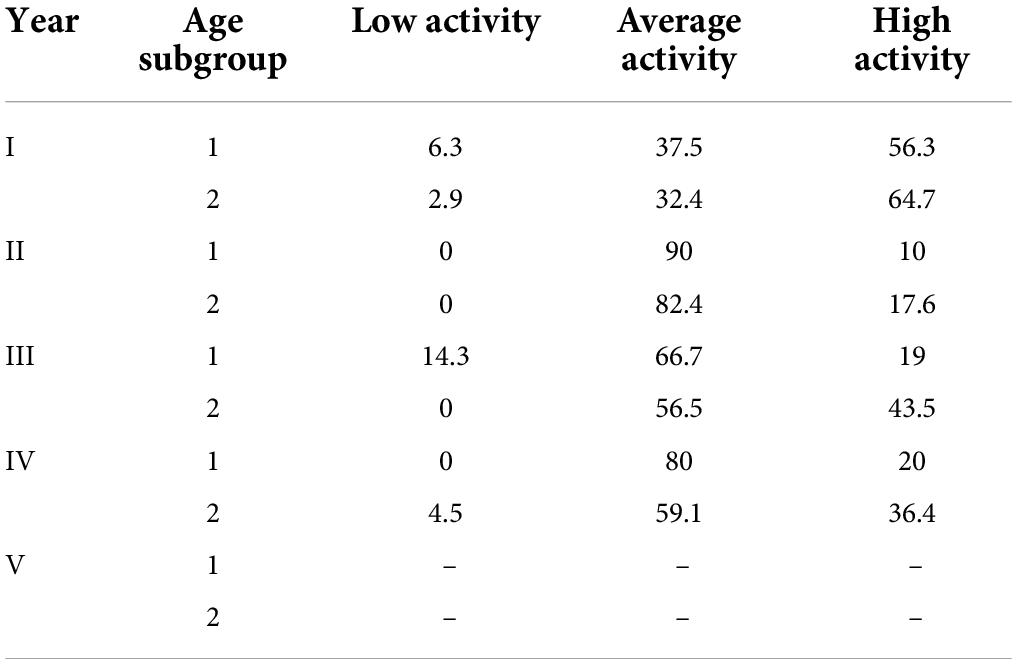
Table 4. Frequency of occurrence of different activity levels in psychology students before classes (in %).
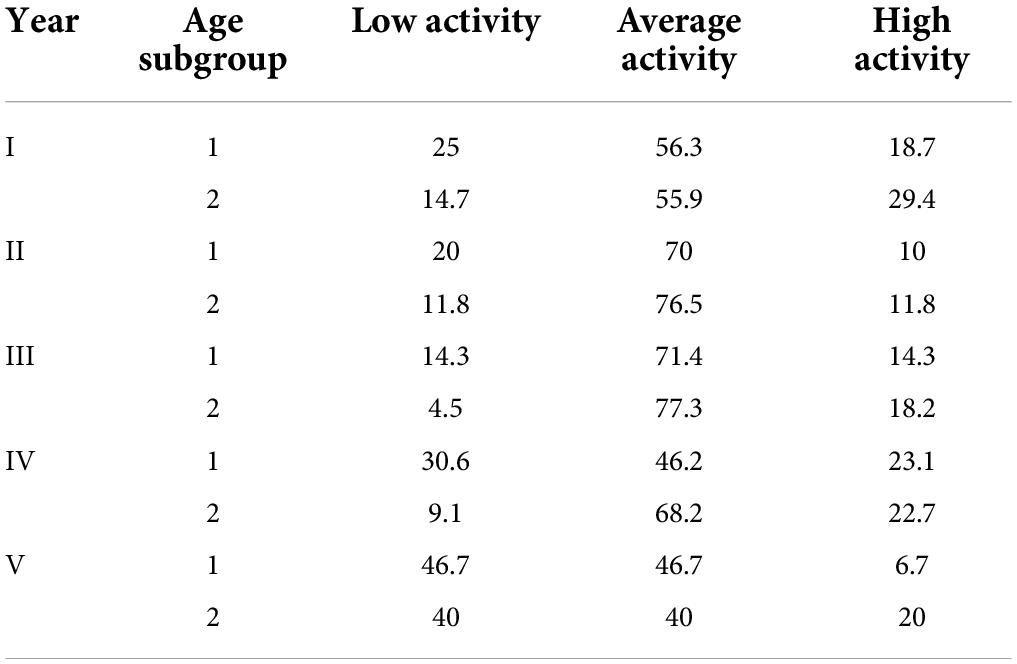
Table 5. Frequency of occurrence of different levels of activity in psychology students after classes (in %).
Most of the full-time and part-time psychology students (weekend groups) in the first year of study were found to have high levels of mobility, speed, and rate of psychophysical functioning before the start of classes in the first and second age groups (Table 4). Thus, the frequency of a high level of psychophysical activity in full-time and part-time first-year psychology students (weekend groups) in the first and second age groups before the start of classes was 56.3 and 64.7% of the cases, respectively. Most full-time and part-time psychology students in both age groups in the second, third, and fourth years had average levels of mobility, speed, and psychophysical functioning before starting classes. Thus, the frequency of occurrence of an average level of expression of the activity of psychophysical processes in full-time and part-time psychology students (weekend groups) of the second, third, and fourth years of study in both age groups was 90, 82.4, 66.7, 56.5, 80, and 59.1% of cases, respectively. The results indicate that the intensity and extent of interaction between psychology students and the subjects of pedagogical relations (lecturers, methodologists, and other students), which corresponded to a high level of activity, were observed at the beginning of lectures only in the first-year psychology students in both the first and second age groups. Second- and third-year students attended quiet, proactive levels of intensity and extent of psychology students’ interaction with the university’s educational environment.
Within each year of study, a comparison of the two age groups according to the level of activity at the beginning of lectures was performed using Pearson’s chi-square test. Significant differences were found in the distribution of activity levels at the beginning of classes between first, second, third, and fourth-year students in both the first and second age subgroups (for first age group students–p = 0.012, for the second–p = 0.033). Thus, age-related differences in the significance of the mobility level and the speed and rate of psychophysical functions were found between the study years at the beginning of teaching.
The results of the study of the mobility level, speed, and rate of psychophysical functions before the beginning of educational activity in full-time and part-time psychology students (weekend groups) from the first to the fourth year of study showed that a high activity level of the subjects with participants in educational relationships is characteristic only for psychology students in the first year of study in both age subgroups. A quiet, proactive level of intensity and interaction with the university’s educational environment is characteristic of second-and third-year students in both age subgroups. In addition, age-related differences in the expression of the level of mobility, speed, and tempo of psychophysical functions were found at the beginning of educational activity between study years.
Most subjects showed an average activity level when they completed their learning activity (Table 5). Thus, the frequency of occurrence of moderate level of mobility, speed, and tempo of psychophysical functions in full-time and part-time psychology students (weekend groups) of first and second-age subgroups at the end of classes (lectures, seminars) was in the range of 40−77.3% of cases. The obtained data indicate that at the end of lectures, most of the respondents of the first, second, third, fourth, and last year of study of the first and second age subgroups had a quiet, proactive level of intensity and extent of interaction with the educational environment of the college. Data analysis suggests that the number of subjects in both age subgroups with low activity levels increased toward the end of the lecture period (Tables 4, 5). Thus, the minimum increase in the number of psychology students with a low activity level at the end of the lecture period was 4.5% (students of the second age group of the third year), and the maximum–was 30.6% (students of the first age group of the fourth year). The data show that the number of psychology students with a low activity level at the end of classes tends to increase.
The results of the shift in activity during educational activity among full-time and part-time psychology students (weekend groups) from the first to the fourth year of study in the first and second age groups are presented in Figures 7–10. A high level of activity at the beginning and the end of classes was registered in 31.3% of cases–among psychology students aged 19–28–and in 23.5% of cases–among psychology students aged 29–56. A moderate activity level was recorded in the second, third, and fourth-year subjects in the first and second age subgroups at the beginning and end of the lessons. The frequency of occurrence of an average activity level at the beginning and end of classes among respondents in the first and second age subgroups tended to decrease from the second to the fourth year of study.
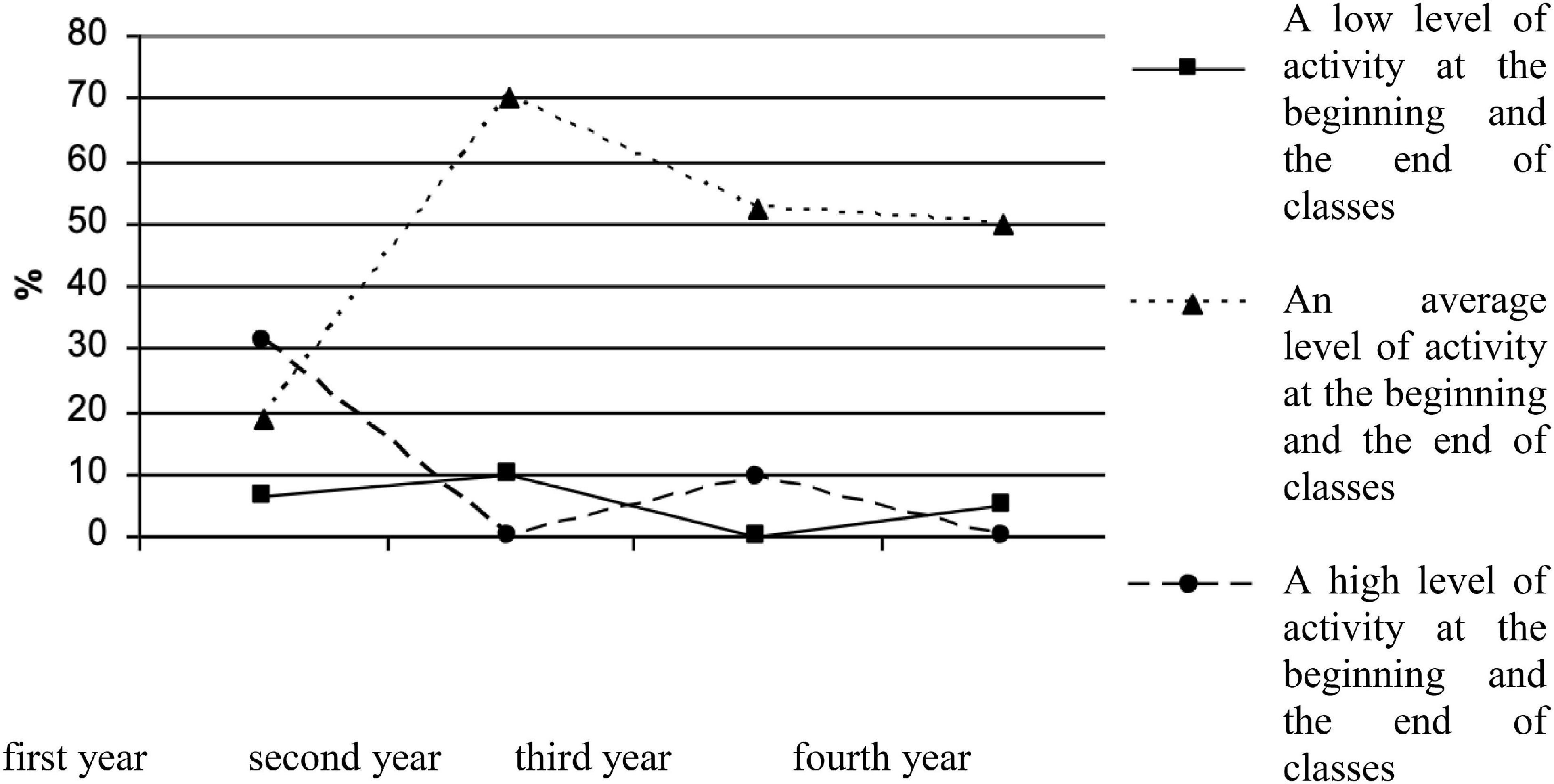
Figure 7. Frequency of occurrence of the zero shift patterns in the level of activity among psychology students of the first age subgroup from the beginning to the end of classes (in %).
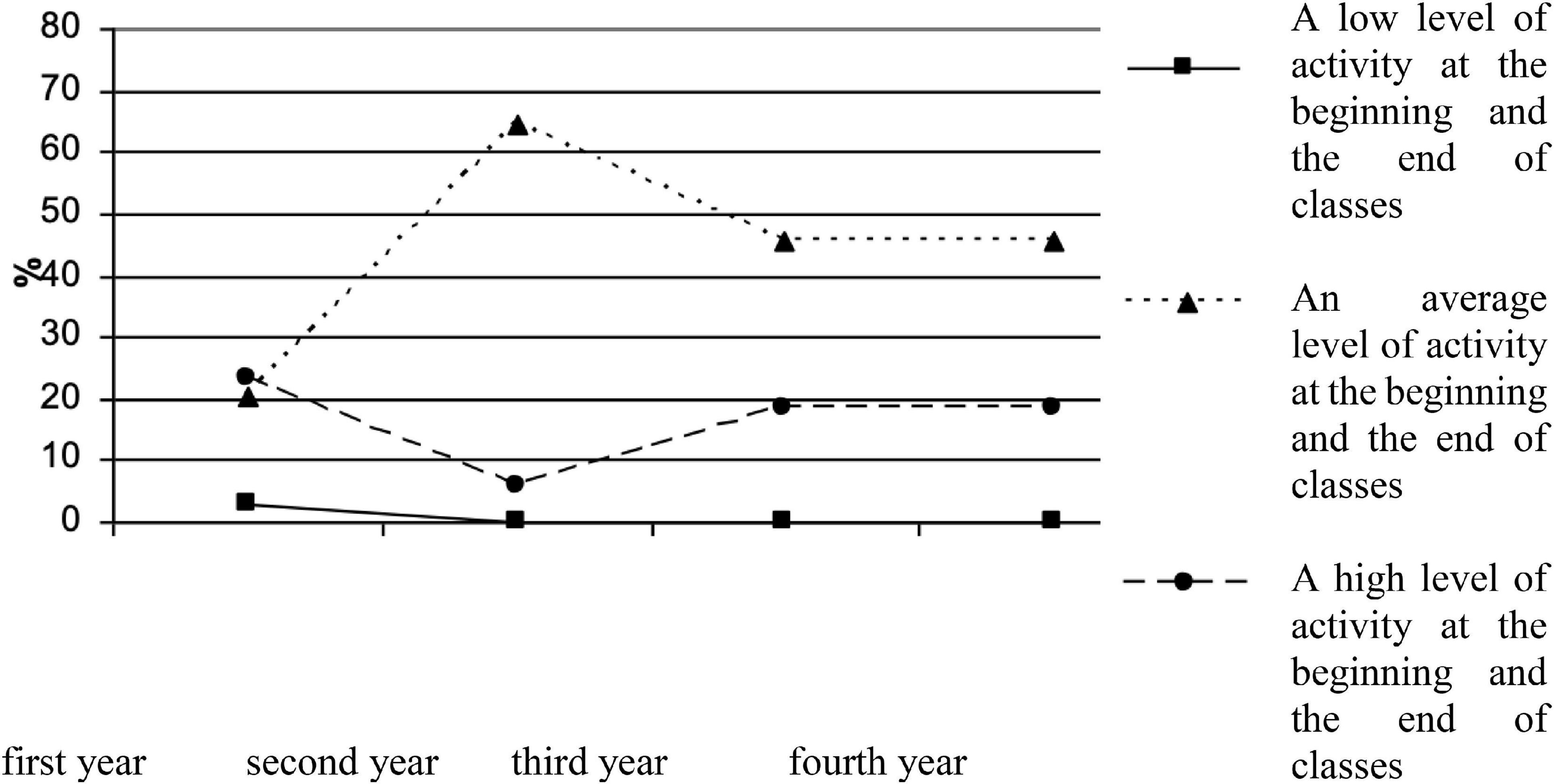
Figure 8. Frequency of occurrence of zero-shift patterns in activity level among psychology students in the first age subgroup from the beginning to the end of instruction (%).
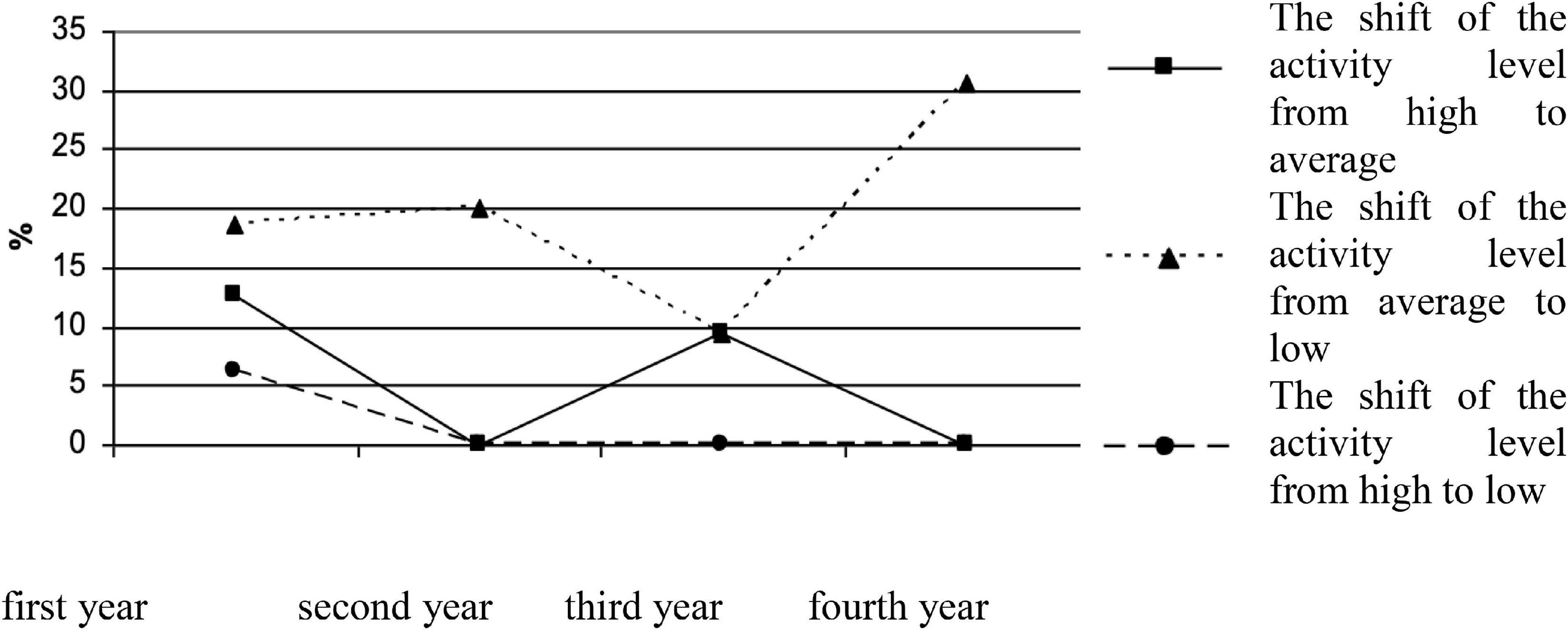
Figure 9. Frequency of occurrence of shift patterns in the activity level among psychology students of the first age subgroup from the beginning to the end of classes (in %).
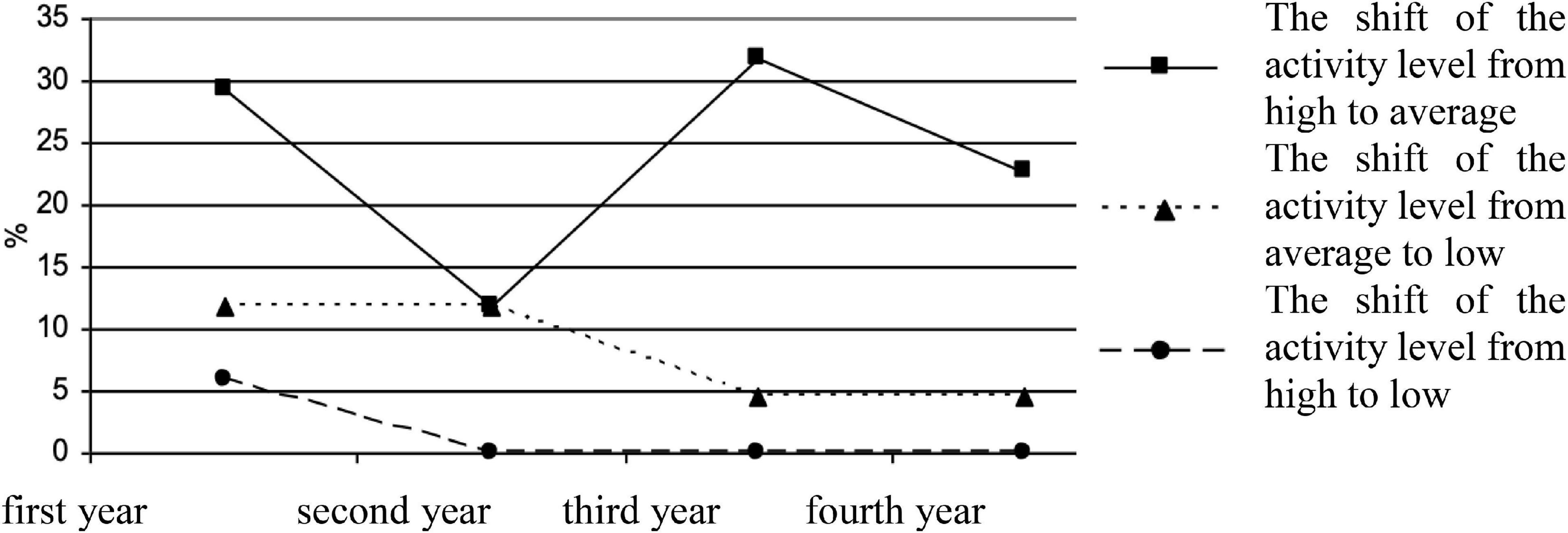
Figure 10. Frequency of occurrence of shift patterns in the activity level in psychology students of the second age subgroup from the beginning to the end of classes (in %).
A shift in mobility, speed, and tempo of psychophysical functions from an average to a low level is the most common variant of the transition of activity level during the academic day for full-time and part-time psychology students of the first age group (weekend groups). As shown in Figure 10, the shift of mobility, speed, and tempo of psychophysical functions from a high to an average level is the most frequent pattern of the transition of activity level during the academic day for full-time and part-time psychology students (weekend groups). The results of the frequency of occurrence of different levels of strength, health, and fatigue (physical health) in full-time and part-time psychology students (weekend groups) before and after distance learning are shown in Tables 6, 7. A high level of good physical health was found in 68.8 and 70.6% of subjects in the first and second age groups, respectively, before the start of classes.
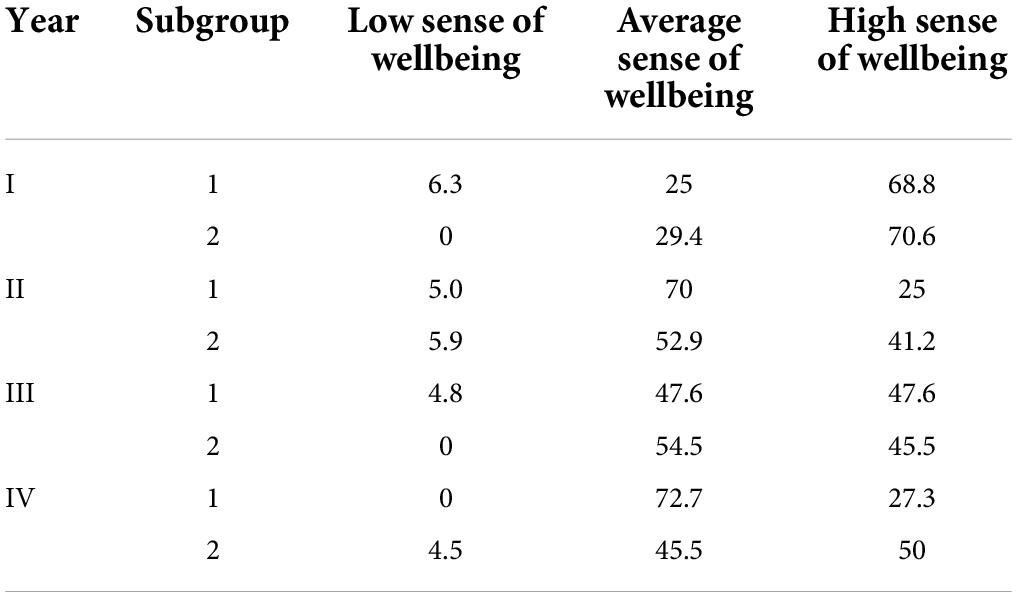
Table 6. Frequency of occurrence of different levels of wellbeing in psychology students before classes (in %).
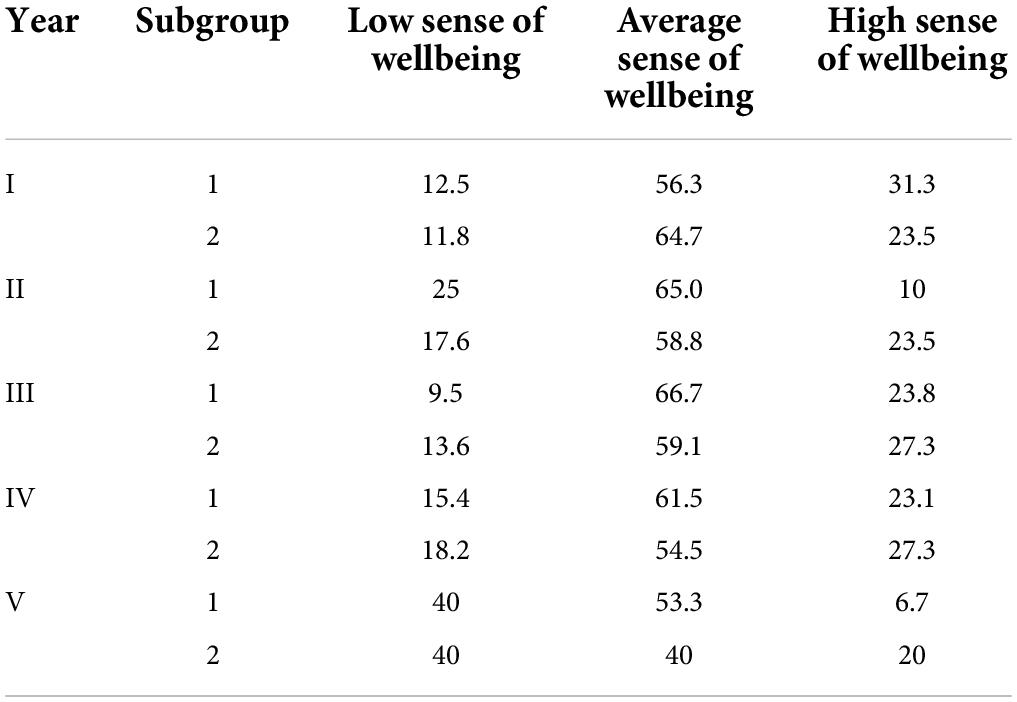
Table 7. Frequency of occurrence of different wellbeing levels in psychology students after classes (in %).
The obtained results indicate that the upcoming educational process evokes subjective sensations reflecting a high level of physiological and psychological wellbeing concerning a person’s internal strain, the direction of thoughts and feelings in most of the full-time and part-time psychology students (weekend groups) of the first year of study, aged between 19 and 56 years. The frequency of occurrence of average wellbeing at the end of classes (lectures, seminars) in full-time and part-time psychology students (weekend groups) of the first, second, third, fourth, and fifth years of study in the first and second age subgroups ranged from 40 to 66.7%. The data analysis shows that at the end of the distance learning activity, subjects with low subjective feelings of physiological and psychological comfort in the internal strain increased (Tables 6, 7). Thus, the minimum increase in the number of psychology students with a low level of wellbeing at the end of classes was 4.7% (among students of the second age group of the third year), the maximum–20.0% (among students of the first age group of the fourth year).
The results of the conducted study indicate that distance learning negatively impacts the psychophysiological strain of female and male students aged between 19 and 56 years. As a result of distance learning, students experience a shift toward a decrease in general background wellbeing, activity, and mood; NPS increases; situational anxiety increases. We also conducted a Spearman’s correlation analysis to examine the relationship between NPS, activity, mood, wellbeing, and situational anxiety at the beginning and end of online instruction for full-time and part-time psychology students (weekend groups) from the first to the fourth year of study in the first and second age groups. The results of the correlation analysis for full-time and part-time psychology students (weekend groups) from the first to the fifth year of study in the first age subgroup show that (1) Positive correlations with a significance level of 0.01 were found between wellbeing and activity; wellbeing and mood; activity and mood (significance level p = 0.05) before the start of educational activities. Negative correlations (p = 0.01) were found between neuropsychological stress and wellbeing, neuropsychological stress and mood; (2) Positive correlations (p = 0.01) were found between wellbeing and activity, wellbeing and mood, and activity and mood at the end of educational activities. In addition, negative correlations (p = 0.01) were found between neuropsychological distress and wellbeing, neuropsychological distress and mood, and neuropsychological distress and activity. The results of the correlation analysis for full-time and part-time psychology students (weekend groups) from the first to the fourth year of study in the second age subgroup show that (1) Before the start of the study, positive correlations (p = 0.01) were found between wellbeing and activity; wellbeing and mood; activity and mood; with a significance level of p = 0.05 between mood and situational anxiety. In addition, negative correlations (p = 0.01) were found between SNP and wellbeing; NPS and mood; (2) Positive correlations (p = 0.01) were found between health status and activity, health status and mood, and activity and mood at the end of the educational activity. Negative correlations (p = 0.01) were found between NPS and wellbeing; (p = 0.01) and mood; NPS and activity; with a significance level of p = 0.05–between mood and situational anxiety, wellbeing, and situational anxiety. (3) Positive correlations with a significance level of p = 0.01 were found between changes in wellbeing and mood; wellbeing and activity; mood and activity. Negative correlations with a significance level of p = 0.01 were found between the change in NPS and wellbeing, NPS and mood, and NPS and activity.
Discussion
The aim of this study was to examine the psychophysiological strain of higher education students in relation to distance education during the pandemic. The results obtained from the present study showed that, in general, distance learning format increased neuropsychic strain, decreased mood, activity, and wellbeing, and increased situational anxiety in college students. Based on the obtained results, social pedagogical educational technologies were developed, and hybridity, interactivity, multiformat, and feedback were identified as the main factors for their success. In general, the results of this study are not comparable to those of previous studies because no study examined the psychophysiological strain of students during the pandemic COVID-19. While researchers have conducted some studies on the psychophysiological stress of college students, they have found no commonalities. From this point of view, the results are not comparable with those of Beltrán-Velasco et al. (2020) and Rodriguez-Besteiro et al. (2021).
Competency indicators must be determined based on the student’s ability to train, effectiveness, and performance in mastering the training program in offline learning, online learning, and blended learning. In order to determine the most effective form of training at a given time of knowledge acquisition, it is necessary to create electronic educational resources with different levels of complexity. It is necessary to pedagogically monitor the process and results of skill acquisition in different formats to determine the effectiveness of the learning process. This procedure ensures the highest level of objectivity in the assessment of knowledge, formation of competencies and the level of satisfaction of participants in educational relationships. Variable observation allows participants in the educational process to identify the dynamics of knowledge acquisition or difficulties in learning certain indicators of competence and provides opportunities for adjusting the educational path.
In addition, social pedagogical educational technologies should be developed taking into account the following factors for the success of the learning process: Hybridity, interactivity, multi-format options, and feedback. In addition, digital education should include blended learning technologies, social psychological programs for developing educational relationships, and new digital educational and methodologies (learning games, digital simulators, and artificial intelligence capabilities).
Conclusion
The analysis conducted allows us to draw the following conclusion. At the beginning of online learning activities, in full-time and part-time psychology students (weekend groups) from the first to the fourth year, in the first and second age groups, with an increase in the level of neuropsychic load, the level of mood, activity, and wellbeing decrease; with an increase in the level of wellbeing, the level of mood and activity increase; with increased activity, mood also increases. At the end of online learning, full-time and part-time psychology students (weekend groups) from the first to the fourth year of study in the first and second age groups showed an increase in the level of neuropsychic load and a decrease in the level of mood, activity, and wellbeing; an increase in the level of situational anxiety and its decrease.
In light of these research findings, we conclude that digital education should include both online and traditional learning (offline) as well as forms of blended learning. The educational process in a digital environment should provide an individually differentiated approach based on a wide range and different sources of didactic material. An individually differentiated approach must be built on the basis of modular education with the possibility of continuity between the stages of knowledge acquisition to achieve continuity in the formation of the necessary competencies, taking into account the level of formation of competencies at the previous stage to enable the start of the next stage (Ge et al., 2017; Brooks et al., 2020; Cao et al., 2020; Husain et al., 2020).
Limitations
The present study also has some limitations. One limitation was that our data were self-reported, which may lead to a serious risk of bias. However, because the main instrument used to collect data was questionnaires, no other methods of analysis were possible. Future studies could look at a variety of data collection instruments. As a future research direction, we propose to analyze the influence of cultural differences on psychophysiological stress in college students. In addition, this study could be extended to other courses of study.
Data availability statement
The raw data supporting the conclusions of this article will be made available by the authors, without undue reservation.
Author contributions
All authors have sufficiently contributed to the study and agreed with the results and conclusion.
Conflict of interest
The authors declare that the research was conducted in the absence of any commercial or financial relationships that could be construed as a potential conflict of interest.
Publisher’s note
All claims expressed in this article are solely those of the authors and do not necessarily represent those of their affiliated organizations, or those of the publisher, the editors and the reviewers. Any product that may be evaluated in this article, or claim that may be made by its manufacturer, is not guaranteed or endorsed by the publisher.
References
Ammerman, B. A., Burke, T. A., Jacobucci, R., and McClure, K. (2020). Preliminary investigation of the association between COVID-19 and suicidal thoughts and behaviors in the U.S. Center for Open Science. J. Psychiatr. Res. Online Advanced Publication, doi: 10.1016/j.jpsychires.2020.12.037
Bayanova, A. R., Sabaeva, E. K., Sakhipova, Z. M., Zatsepina, M. B., Tararina, L. I., Votinov, A. A., et al. (2019). Educational environment ecology as factor of university teacher health saving in context of education and science reforms in modern Russia. Ekoloji 28, 4937–4941.
Beltrán-Velasco, A. I., Bellido-Esteban, A., Ruisoto-Palomera, P., Mendoza, K. H., and Clemente-Suárez, V. J. (2020). The effect of cultural differences in psychophysiological stress response in high education context: a pilot study. Appl. Psychophysiol. Biofeedback 45, 23–29. doi: 10.1007/s10484-019-09452-0
Bonke, B., Smorenburg, J. M. J., van der Ent, C. K., and Spielberger, C. D. (1987). Evidence of denial and item-intensity specificity in the state-trait anxiety inventory. Pers. Individ. Dif. 8, 185–191. doi: 10.1016/0191-8869(87)90173-5
Bringle, R. G., and Clayton, P. H. (2020). Integrating service learning and digital technologies: examining the challenge and the promise. RIED 23, 43–65. doi: 10.5944/ried.23.1.25386
Brooks, S. K., Webster, R. K., Smith, L. E., Woodland, L., Wessely, S., Greenberg, N., et al. (2020). The psychological impact of quarantine and how to reduce it: rapid review of the evidence. Lancet 395, 912–920.
Cao, W., Fang, Z., Hou, G., Han, M., Xu, X., Dong, J., et al. (2020). The psychological impact of the COVID-19 epidemic on college students in China. Psychiatr. Res. 287:112934.
Clemente-Suárez, V. J., Dalamitros, A. A., Beltran-Velasco, A. I., Mielgo-Ayuso, J., and Tornero-Aguilera, J. F. (2020). Social and psychophysiological consequences of the COVID-19 pandemic: an extensive literature review. Front. Psychol. 11:580225. doi: 10.3389/fpsyg.2020.580225
Dhahri, A. A., Arain, S. Y., Memon, A. M., Rao, A., Khan, M. M., Hafeez, G., et al. (2020). The psychological impact of COVID-19 on medical education of final year students in Pakistan: a cross-sectional study. Annal. Med. Surg. 60, 445–450. doi: 10.1016/j.amsu.2020.11.025
Dryhurst, S., Schneider, C. R., Kerr, J., Freeman, A. L. J., Recchia, G., van der Bles, A. M., et al. (2020). Risk perceptions of COVID-19 around the world. J. Risk Res. 23, 994–1006.
Fiorillo, A., and Gorwood, P. (2020). The consequences of the COVID-19 pandemic on mental health and implications for clinical practice. Eur. Psychiatr. 63, 1–4.
Garcia-Gutiérrez, J., Ruiz-Corbella, M., and del Pozo, A. (2020). Innovation and virtual service-learning: key elements for experience-based reflection. RIDAS 9, 62–80. doi: 10.1344/RIDAS2020.9.4
Garciìa-Gutieìrrez, J., Ruiz-Corbella, M., and Riesco, A. ìM. (2021). Virtual service-learning in higher education. a theoretical framework for enhancing its development. Front. Educ. 5:630804. doi: 10.3389/feduc.2020.630804
Garrity, T. F., Marx, M. B., and Somes, G. W. (1977). Langner’s 22-item measure of psychophysiological strain as an intervening variable between life change and health outcome. J. Psychosom. Res. 21, 195–199. doi: 10.1016/0022-3999(77)90090-3
Ge, L., Yap, C. W., Ong, R., and Heng, B. H. (2017). Social isolation, loneliness and their relationships with depressive symptoms: a population-based study. PLoS One 12:e0182145.
Gerhold, L. (2020). COVID-19: Risk Perception and Coping Strategies. Charlottesville, VA: Center for Open Science.
Ho, C. S., Chee, C. Y., and Ho, R. C. (2020). Mental health strategies to combat the psychological impact of COVID-19 beyond paranoia and panic. Ann. Acad. Med. Singapore 49, 1–3.
Holmes, E. A., O’Connor, R. C., Perry, V. H., Tracey, I., Wessely, S., Arseneault, L., et al. (2020). Multidisciplinary research priorities for the COVID-19 pandemic: a call for action for mental health science. Lancet Psychiatry 7, 547–560. doi: 10.1016/S2215-0366(20)30168-1
Husain, S. F., Yu, R., Tang, T.-B., Tam, W. W., Tran, B., Quek, T. T., et al. (2020). Validating a functional near-infrared spectroscopy diagnostic paradigm for major depressive disorder. Sci. Rep. 10:9740. doi: 10.1038/s41598-020-66784-2
Kayumova, L. R., Gainullina, L. N., Akhmadieva, R. S., Matvienko, V. V., and Kabakhidze, E. L. (2021). Using interactive platform “round” to organize online leisure activities for children during the pandemic. Eurasia J. Math. Sci. Technol. Educ. 17:em2016. doi: 10.29333/ejmste/11182
Kugurakova, V. V., Golovanova, I. I., Shaidullina, A. R., Khairullina, E. R., and Orekhovskaya, N. A. (2021). Digital solutions in educators’ training: concept for implementing a virtual reality simulator. Eurasia J. Math. Sci. Technol. Educ. 17, 1–10. doi: 10.29333/ejmste/11174
Masalimova, A. R., Korzhuev, A. V., Vasbieva, D. G., Galushkin, A. A., Maydangalieva, Z. A., and Zaitseva, N. A. (2019). Preservation of national languages as a factor of national security in the contemporary world. Eur. J. Sci. Theol. 15, 113–121.
Meija, A. (2020). Community-engaged learning in times of COVID-19 or why I’m not prepared to transition my class into an online environment. Publ. Philos. J. 3, 1–6. doi: 10.25335/PPJ.3.1-3
Mohammadi, G., Tourdeh, M., and Ebrahimian, A. (2019). Effect of simulation-based training method on the psychological health promotion in operating room students during the educational internship. J. Educ. Health Promot. 8:172. doi: 10.4103/jehp.jehp_106_19
Montiel, H., and Georgina, G.-Z. M. (2022). Rock the Boat! Shaken by the COVID-19 crisis: a review on teachers’ competencies in ICT. Front. Educ. 6:770442. doi: 10.3389/feduc.2021.770442
Petrakova, A. V., Kanonire, T. N., Kulikova, A. A., and Orel, E. A. (2021). Teachers under stress during the COVID-19 pandemic: analysis of a successful case. MCU J. Pedagogy Psychol. 4, 90–104. doi: 10.25688/2076-9121.2021.58.4.05
Qarkaxhja, Y., Kryukova, N. I., Cherezova, Y. A., Rozhnov, S. N., Khairullina, E. R., and Bayanova, A. R. (2021). Digital transformation in education: teacher candidate views on mobile learning. Int. J. Emerg. Technol. Learn. 16, 81–93.
Rodriguez-Besteiro, S., Tornero-Aguilera, J. F., Fernández-Lucas, J., and Clemente-Suárez, V. J. (2021). Gender differences in the COVID-19 pandemic risk perception, psychology, and behaviors of Spanish University students. Int. J. Environ. Res. Public Health 18:3908. doi: 10.3390/ijerph18083908
Salakhova, V. B., Erofeeva, M. A., Pronina, E. V., Belyakova, E., Zaitseva, N. A., and Ishmuradova, I. I. (2021a). State regulation and development of digital educational platforms. World J. Educ. Technol. Curr. Issues 13, 956–966. doi: 10.18844/wjet.v13i4.6282
Salakhova, V. B., Masalimova, A. R., Belyakova, N. V., Morozova, N. S., Osipova, N. V., and Prokopyev, A. I. (2021b). Competitive teacher for higher education: risk-based models of its development. Eurasia J. Math. Sci. Technol. Educ. 17:em2021. doi: 10.29333/ejmste/11187
Sood, S. (2020). Psychological effects of the Coronavirus disease-2019 pandemic. Res. Human. Med. Educ. 7, 23–26.
Soylu, Y. (2021). The psychophysiological effects of the COVID-19 quarantine in the college students. Phys. Educ. Stud. 25, 158–163.
Spielberger, C. D. (1985). Assessment of state and trait anxiety: conceptual and methodological issues. South. Psychol. 2, 6–16.
Spielberger, C. D., Goruch, R. L., and Lushene, R. E. (1970). Manual for the State-Trait Anxiety Inxtentory (Self Evaluation Queshonnatre). Palo Alto, CA: Consulhng Psydiologists Press.
Spielberger, C. D., and Reheiser, E. C. (2009). Assessment of emotions: anxiety, anger, depression, and curiosity. Appl. Psychol. Health Well Being 1, 271–302. doi: 10.1111/j.1758-0854.2009.01017.x
Spielberger, C. D., Vagg, P. R., Barker, L. R., Donham, G. W., and Westberry, L. G. (1980). The factor structure of the state-trait anxiety inventory. Stress Anxiety 7, 95–109.
Varlamova, A. I., and Manvelova, I. A. (2021). Consequences of the coronavirus for higher education. MCU J. Pedagogy Psychol. 4, 67–89. doi: 10.25688/2076-9121.2021.58.4.04
Villegas, C. C., Peirolo, S., Rocca, M., Ipince, A., and Bakrania, S. (2021). Impacts of health-related school closures on child protection outcomes: a review of evidence from past pandemics and epidemics and lessons learned for COVID-19. Int. J. Educ. Dev. 84:102431. doi: 10.1016/j.ijedudev.2021.102431
Keywords: COVID-19, distance learning, blended learning, information technology, education
Citation: Babieva NS, Romanova AV, Reznichenko SA, Kosykh OI, Kosolapova NV, Vlasenko LV and Krasheninnikova EI (2022) Digitalization during the era of COVID-19: An analysis of the psychophysiological strain of university students. Front. Educ. 7:961046. doi: 10.3389/feduc.2022.961046
Received: 03 June 2022; Accepted: 06 July 2022;
Published: 25 July 2022.
Edited by:
Muhammet Usak, Kazan Federal University, RussiaReviewed by:
Muharrem Duran, Bozok University, TurkeyYana Korneeva, Northern (Arctic) Federal University, Russia
Copyright © 2022 Babieva, Romanova, Reznichenko, Kosykh, Kosolapova, Vlasenko and Krasheninnikova. This is an open-access article distributed under the terms of the Creative Commons Attribution License (CC BY). The use, distribution or reproduction in other forums is permitted, provided the original author(s) and the copyright owner(s) are credited and that the original publication in this journal is cited, in accordance with accepted academic practice. No use, distribution or reproduction is permitted which does not comply with these terms.
*Correspondence: Nigina S. Babieva, bmlnaW5hc2JhYmlldmFAeWFuZGV4LmNvbQ==; bi5zLmJhYmlldmFAbWFpbC5ydQ==
†ORCID: Nigina S. Babieva, orcid.org/0000-0001-8076-3494; Anzhela V. Romanova, orcid.org/0000-0002-7472-8235; Sergey A. Reznichenko, orcid.org/0000-0002-1539-0457; Oksana I. Kosykh, orcid.org/0000-0002-3517-644X; Natalia V. Kosolapova, orcid.org/0000-0002-3624-0626; Larisa V. Vlasenko, orcid.org/0000-0001-8448-4214; Ekaterina I. Krasheninnikova, orcid.org/0000-0001-7507-255X
 Nigina S. Babieva
Nigina S. Babieva Anzhela V. Romanova2†
Anzhela V. Romanova2† Sergey A. Reznichenko
Sergey A. Reznichenko